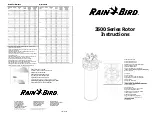
6
HRRS Series
6
Maintenance
Chapter 4
MAINTENANCE
4.1 Maintainability and Reliability
It is possible to maintain Model HRRS indefinitely. It
is reliable due to its closed design and sealed switches
and resistors. The unit is resistant to electromagnetic
interference (EMI) because of its metal enclosure.
4.2 Preventive Maintenance
Keep the unit in a clean environment. This will help
prevent possible contamination.
The front panel should be periodically cleaned to
eliminate any leakage paths from near or around the
binding posts. To clean the front panel:
Wipe the front panel clean using alcohol and a
lint-free cloth
4.3 Verification of Performance
4.3.1 Calibration Interval
The
HRRS
Series instruments should be verified for
performance at a calibration interval of twelve (12)
months. This procedure may be carried out by the user
if a calibration capability is available, by IET Labs,
or by a certified calibration laboratory.
If the user should choose to perform this procedure,
then the considerations below should be observed.
4.3.2 General Considerations
It is important, whenever testing the HRRS Series
Decade Units, to be very aware of the capabilities and
limitations of the test instruments used. A resistance
bridge may be employed, and there are direct-reading
resistance meters or digital multimeters available
that can verify the accuracy of these units, especially
when used in conjunction with standards that can
serve to confirm or improve the accuracy of the test-
ing instrument
Such test instruments must have a 4:1 TUR capabil-
ity for each value calibrated. Note that the accuracy
varies for different decades. A number of commercial
bridges and meters exist that can perform this task;
consult IET Labs.
It is important to allow both the testing instrument
and the HRRS Substituter to stabilize for a number of
hours at the nominal operating temperature of 23°C,
and at nominal laboratory conditions of humidity.
There should be no temperature gradients across the
unit under test.

































